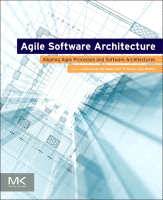Browse content
Table of contents
Actions for selected chapters
- Full text access
- Book chapterAbstract only
Chapter 1 - Making Software Architecture and Agile Approaches Work Together: Foundations and Approaches
Muhammad Ali Babar
Pages 1-22 - Book chapterNo access
Author Index
Pages 375-381 - Book chapterNo access
Subject Index
Pages 383-392
About the book
Description
Agile software development approaches have had significant impact on industrial software development practices. Today, agile software development has penetrated to most IT companies across the globe, with an intention to increase quality, productivity, and profitability. Comprehensive knowledge is needed to understand the architectural challenges involved in adopting and using agile approaches and industrial practices to deal with the development of large, architecturally challenging systems in an agile way.
Agile Software Architecture focuses on gaps in the requirements of applying architecture-centric approaches and principles of agile software development and demystifies the agile architecture paradox. Readers will learn how agile and architectural cultures can co-exist and support each other according to the context. Moreover, this book will also provide useful leads for future research in architecture and agile to bridge such gaps by developing appropriate approaches that incorporate architecturally sound practices in agile methods.
Agile software development approaches have had significant impact on industrial software development practices. Today, agile software development has penetrated to most IT companies across the globe, with an intention to increase quality, productivity, and profitability. Comprehensive knowledge is needed to understand the architectural challenges involved in adopting and using agile approaches and industrial practices to deal with the development of large, architecturally challenging systems in an agile way.
Agile Software Architecture focuses on gaps in the requirements of applying architecture-centric approaches and principles of agile software development and demystifies the agile architecture paradox. Readers will learn how agile and architectural cultures can co-exist and support each other according to the context. Moreover, this book will also provide useful leads for future research in architecture and agile to bridge such gaps by developing appropriate approaches that incorporate architecturally sound practices in agile methods.
Key Features
- Presents a consolidated view of the state-of-art and state-of-practice as well as the newest research findings
- Identifies gaps in the requirements of applying architecture-centric approaches and principles of agile software development and demystifies the agile architecture paradox
- Explains whether or not and how agile and architectural cultures can co-exist and support each other depending upon the context
- Provides useful leads for future research in both architecture and agile to bridge such gaps by developing appropriate approaches, which incorporate architecturally sound practices in agile methods
- Presents a consolidated view of the state-of-art and state-of-practice as well as the newest research findings
- Identifies gaps in the requirements of applying architecture-centric approaches and principles of agile software development and demystifies the agile architecture paradox
- Explains whether or not and how agile and architectural cultures can co-exist and support each other depending upon the context
- Provides useful leads for future research in both architecture and agile to bridge such gaps by developing appropriate approaches, which incorporate architecturally sound practices in agile methods
Details
ISBN
978-0-12-407772-0
Language
English
Published
2014
Copyright
Copyright © 2014 Elsevier Inc. All rights reserved.
Imprint
Morgan Kaufmann
